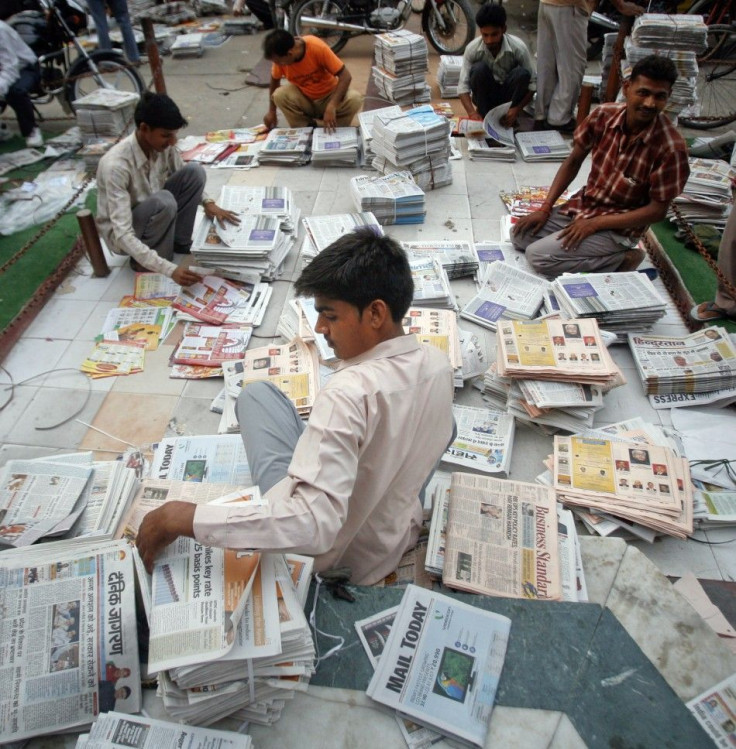Newspaper Boom In Asia Defies Trends In West

While the print newspaper industry has been crippled in developed western countries which are battling digital alternatives, Asian countries are actually witnessing a major boom in newspaper paid circulation.
The growing trend for paid circulation in Asia has increased at a rate of 16 percent during the five-year period between 2006 and 2010, according to an upcoming World Press Trends 2011 report.
The World Association of Newspapers and News Publishers (WAN-INFRA) said that India, China, and Japan are the world's largest newspaper markets with paid circulations of 110 million, 109 million, and 50 million, respectively.
Combined, these three countries' circulations make up more than half of the world's total percentage of paid circulation.
Moreover, 67 of the world's 100 largest daily newspapers are based in Asia, reports Asia 360°.
These figures represent a stark contrast to the steep decline in newspaper print circulation in the United States and Europe.
The U.S. experienced a loss of 17 percent over the same five-year period from 2006 to 2010, according to the WAN-INFRA 2011 report. Europe's paid circulation fell by a total of 33.8 percent during these five years.
In the developed markets, users have been turning to the free Internet for their news. But In Asia, fast economic growth over the last 30 years has led to higher literacy rates as millions have been lifted out of poverty -- driving new readership toward newspapers.
In addition, limited Internet reach prevents free, online news from competing with the traditional subscription model.
According to The Economist, only 7 percent of the Indian population used the Internet regularly in 2010.
Newspapers [in Asia] are the... medium that offers huge penetration compared to other publications, said Jacob Mathew, president of the WAN-INFRA.
The combination of cheap papers, low digital technology use, and the increased literacy rates has opened up Asian markets to newspapers that lament a doomed future in Western countries.
The growing Asian market for newspapers also offers international news organizations a new source of revenue.
For instance, circulation for the Times of India, a subsidiary of the Times Group, has increased to about 4 million. This increase has contributed to an estimated $1 billion revenue increase per year, according to Asia 360°.
Furthermore, along with circulation growth comes advertising growth.
In Asia, advertising revenue has picked up since the 2008 financial crisis by way of a 4 percent increase in 2010, according to Asia 360°.
Trend to Trust?
The economic growth of Asia has allowed for the spread of wealth and literacy leading to the internationalization and revival of the newspaper industry.
Three Japanese daily newspapers are the most widely read in the world. Yomiuri Shimbun has a circulation above 10 million; Asahi Shimbun has 8 million readers, while Mainichi Shimbun boasts 4 million. Meanwhile, The Wall Street Journal has 2 million subscribers.
However, it's still debatable whether the growing trend of paid print circulation will continue once Asians gain more regular access to the Internet.
Print newspaper advocates believe the model is sustainable in Asia, while critics see the issue as simply being postponed.
In the more developed markets of Hong Kong, South Korea, and Taiwan, paid circulation isn't doing as well as in their continental counterparts.
Asia 360° reported circulations falling by 10.3 percent, 3.3 percent, and 15.6 percent for Hong Kong, South Korea, and Taiwan, respectively.
As users have more access to digital technology, they risk giving up their print newspaper for more affordable, mobile, and digital platforms, as users in America and Europe have done in the last decade.
Although economic growth has increased literacy rates in populous Asian countries such as India and China, continued economic growth could also lead to expanded use of digital technology for news sources.
© Copyright IBTimes 2025. All rights reserved.





















